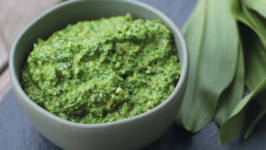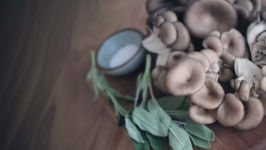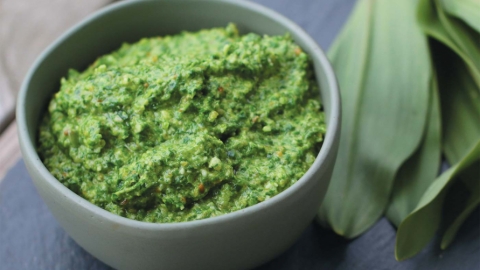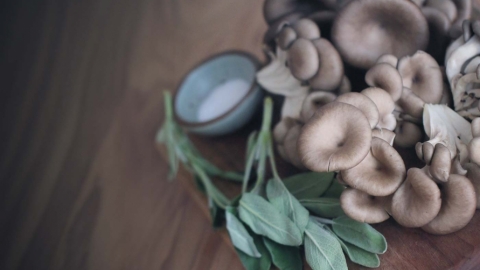Foraging Forest Delights
On a gray April morning, I follow a neighborhood path along a meandering local waterway, stained and swollen with mountain snowmelt. Soon this trail will burst with the purple hue of violets; it will shine with the speckled leaves and drooping yellow flowers of trout lily. But today, at first pass this communal corridor still feels dormant, defined by dusky grays and humble earth tones—caught between the majestic stillness of winter and the vibrant splendor of spring.
The challenging early season conditions only sharpen my attention. Poised and present, I scan the soil for spring secrets, looking for quiet clues. A small log, covered in the desiccated remnants of last fall’s turkey tail mushrooms (Trametes versicolor), captures my attention, but this colorful medicinal will not bear new fruit until summer. Rather than being a distraction, the expired turkey tails hone my vision, and soon I have spotted a bright red, toilet plunger–shaped mushroom that contrasts boldly with the mud-season medley of thawing soil, slush, and snow. Scarlet cups (Sarcoscypha coccinea) are not exactly table fare, but their brilliant hue stuns the senses, illuminating the hidden potential of the path ahead.
Spring is an uplifting time in Vermont’s forests, as the landscape stirs from its winter slumber and we witness the year’s first flush of wild edible plants and mushrooms. Each outing becomes a treasure hunt, a source of inspiration and renewal, as ostrich ferns unfurl along sandy riverbanks and black morels reappear in the shadow of tried-andtrue ash trees.
As your forager’s eyes rediscover their rhythm, don’t forget to look up as well as down. Ground-dwelling morels may be spring’s most precious prize, yet they are camouflaged and capricious, the best spots often shrouded in secrecy. Meanwhile, the spring oyster mushroom commands our attention, fruiting in generous clusters way up in the poplar trees. While oysters lack the mystique of morels, they are a reliable and resilient edible, offering an outstanding umami flavor, anise aroma, and meaty texture. Yet oysters are not a beginner species—watch out for toxic look-alikes such as the angel wing (Pleurocybella porrigens), which favors coniferous substrate and primarily fruits in autumn.
For new hunters, the diversity and nuance of our region’s wild plants and fungi— from savory to sickening—can be overwhelming. Try narrowing your focus: it is safer and more satisfying to master identification of one spring mushroom or green with 100-percent certainty, than to learn a slew of species without confidence. Take the time to observe your target species at each stage in its development, and to familiarize yourself with its preferred habitat, look-alikes, and key distinguishing features. Once you have developed the requisite depth of experience it takes to know one or two species with complete conviction, you can add new forest flavors to your list each season as your passion and proficiency develop.
Whether yellow, black, or half-free, true morels are a spring delicacy of global culinary renown. Here in Vermont, morels are undeniably present, but finding them can vary from effortless to, more often, fiendishly difficult.
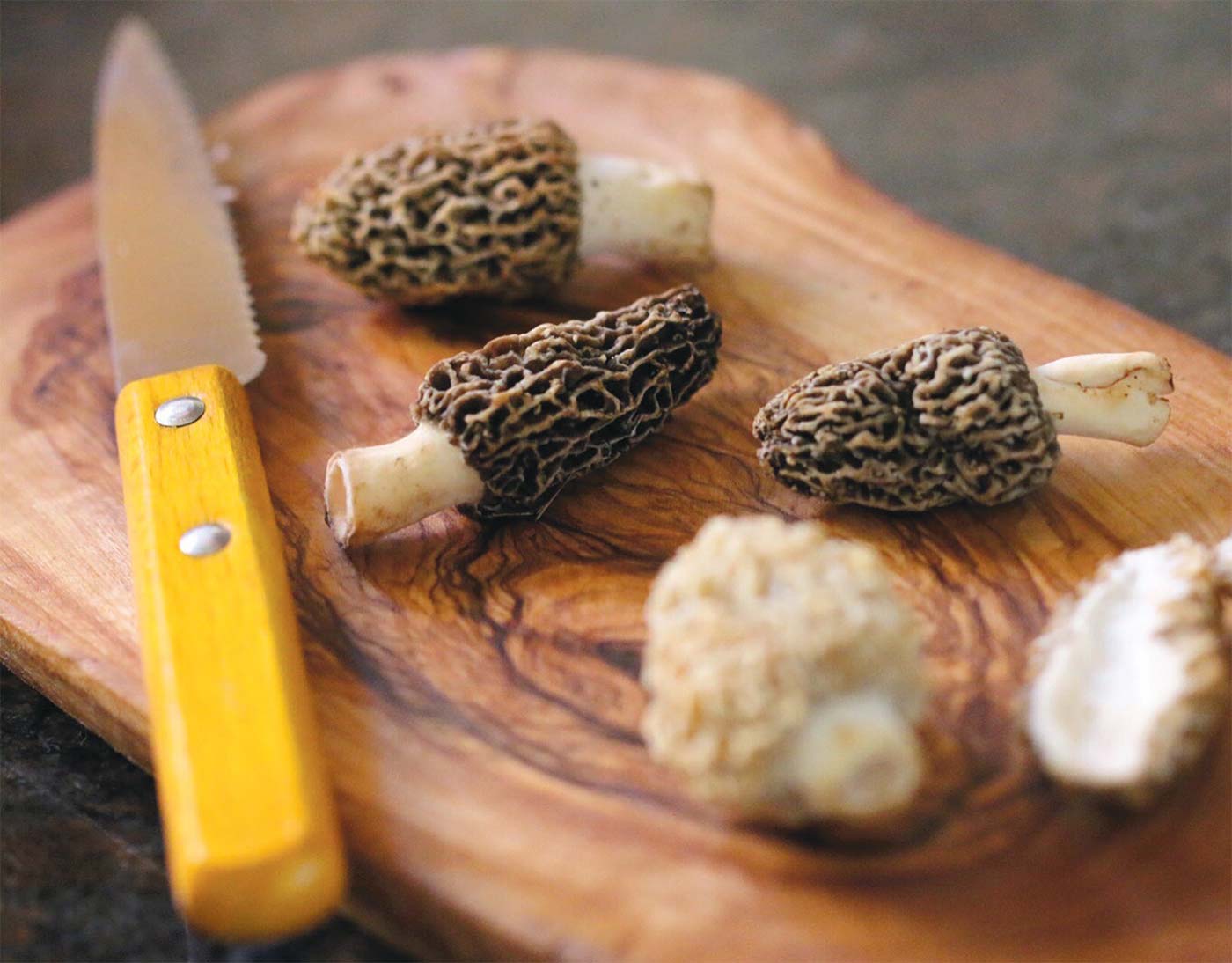
A selection of freshly harvested morels ready to hit the frying pan. Sliced open, true morels are completely hollow from tip to tail.
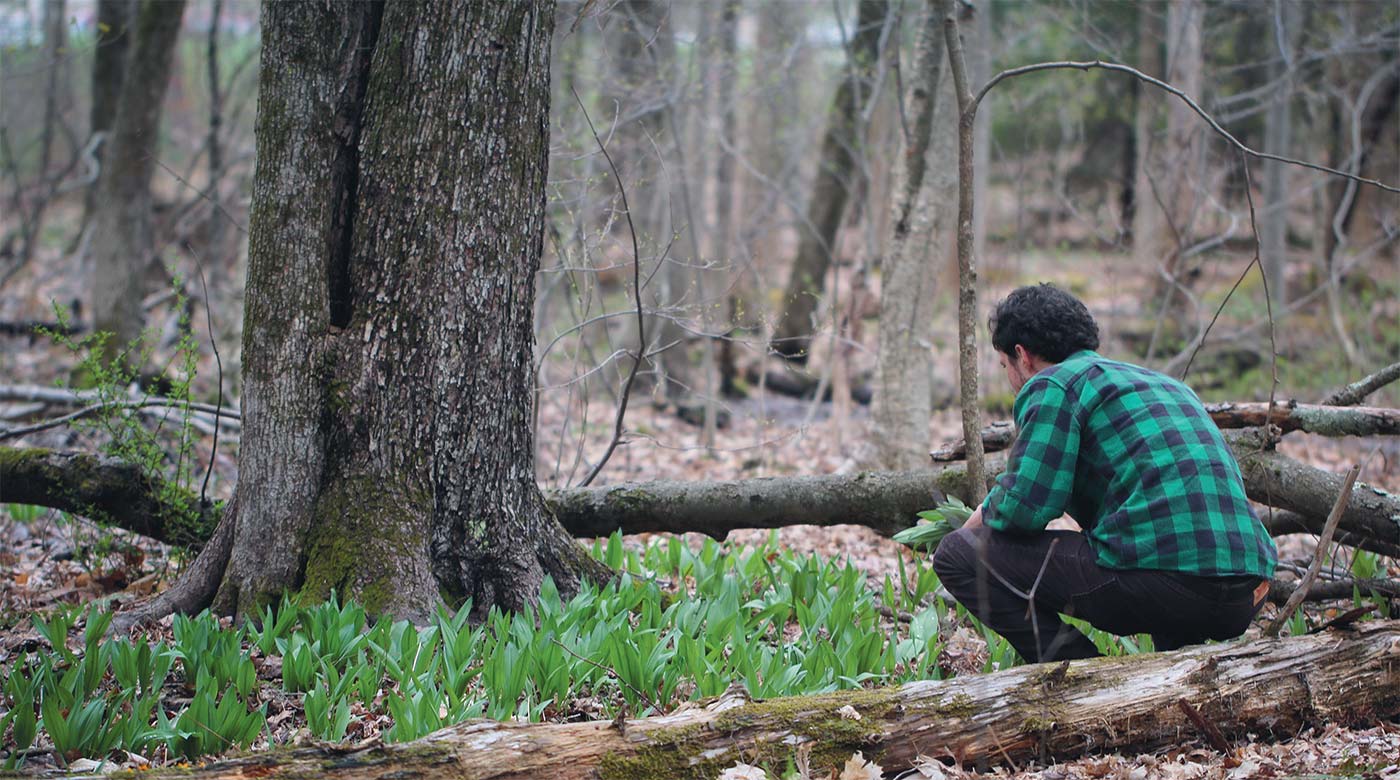
Ari Rockland-Miller selectively harvests ramp leaves in early spring.
For the total neophyte, there may be no better starting place for the spring foray than Dryad’s saddle, Polyporus squamosus. The overlooked Dryad’s saddle (also known as the pheasant back mushroom) is an easily encountered spring confidence booster, its kidney-shaped conks plainly visible on the standing or downed trunks of elm, silver maple, and box elder trees. This annual polypore produces a fresh flush of fruiting bodies each spring as rain allows, its squishy white, angular pore surface smelling like watermelon rind or cucumber. Breaking through bark, it emerges as a small cluster of tan, fleshy nubs, marked by a matrix of brown scales. The fast-growing cap is connected to an off-center stem that develops a dark, woolly stubble at its base. True to its common name, this spring species develops into a bloated slab, tough and leathery, like a sylvan saddle fit for the most discerning tree nymph. Unless you plan to simmer a saddle in soup stock, this spring mushroom is best harvested young and tender, when it makes a fine sauté that can be elevated in the hands of seasoned chefs.
But let’s face it, even the most dedicated Dryad’s saddle aficionado is perennially hoping to stumble upon a windfall of magnificent morels. Whether yellow, black, or half-free, true morels are a spring delicacy of global culinary renown. Here in Vermont, morels are undeniably present, but finding them can vary from effortless to, more often, fiendishly difficult. Oddly, morels are both picky and pickable—discerning regarding soil texture (sandy loam), tree composition (mature ash, ancient apple, or recently deceased elm), timing (May), and slope aspect (south-facing is favorable); but also quite capable of skirting expectations, popping up proudly beneath our noses.
I’ll chalk it up to beginner’s luck, but my neighbor invariably finds a trio of black morels at the earliest possible hour each spring, unmissable right beneath his mailbox. Of course, he is always kind enough to promptly text me a photo, leaving me feeling woefully inadequate, scratching my head, and questioning my own morel prowess.
The black morel (Morchella angusticeps) typically arrives first on the scene in late April or early May, soon followed by the rarer, smaller half-free (Morchella punctipes), its pitted tip sporting a skirt that is only partially connected to the stem. (The latter is sometimes colloquially referred to as the peckerhead morel; we’ll leave the etymology to the reader’s imagination.) Yellow morels, also called blondes (Morchella esculentoides), fruit for the majority of the May through early June season, and are responsible for the largest finds by weight in Vermont forests each spring. Research suggests the popular “gray” morel is not a distinct species, but a phenotype (or younger version) of the yellow. Of importance, all three species of true morels found in our region are hollow from tip to tail and should be sliced open to confirm the interior lacks the cottony wisps or brain-like folds associated with toxic look-alikes in the genera Verpa or Gyromitra.
This spring, step outside and take a walk through a local woodland, treading lightly with open eyes and gentle expectations.

Scarlet cups illuminate the April forest floor with a stunning splash of color. These beauties are not considered table fare, but they are a good sign that morels might be arriving soon.
Of course, it’s not just mushrooms that make spring showings—a wealth of wild plants also thrive in this fleeting season. Nettles, nestled into the meadow’s unkept border, enliven neglected corners with purple-green, stinger-studded shoots that make a richly vegetal tea or quiche filling. We have two noteworthy species of nettle here in Vermont—the more common field nettle (Urtica dioica), thriving in full sun or at pasture’s edge, and wood nettle (Laportea canadensis), with broader leaves to capture filtered light in the forest understory. Don’t forget long pants and gloves: both nettle species sport myriad hairlike stingers on their stems and beneath their leaves. Thankfully, cooking defangs this oft-maligned weed, turning it into a worthy spinach substitute and spring tonic.
Ramps (Allium tricoccum), pungent and pristine, are ever-ready, seizing the moment before leaf-out when sunlight spills down through the open hardwood canopy and warms the soil. These fiery and nutritious native leeks can sometimes carpet broad swaths of ground, but they are slow-growing and sensitive, vulnerable to overharvest and reliant on the presence of a deciduous canopy above. Ethical harvest is paramount: selectively snipping leaves, letting the vast majority of the patch go to seed, and leaving bulbs in the ground whenever possible.
While ramps are defined by their signature garlic scent and early spring ground-cover growth habit, in recent years there have been a spate of poisonings from those confusing ramps with the toxic false hellebore (Veratrum viride)—which features broad, spiral-arranged leaves with prominent parallel veins. Humility and prudence are paramount for those who aspire to partake in the ramp ritual.
Unlike morels, ostrich ferns are easy to locate each spring once you have discovered a spot, last year’s brown fertile fronds marking the perennial patch like feathery flags.
Ramps may be the quintessential spring ephemeral, yet the ostrich fern (Matteuccia struthiopteris) has an even shorter window of harvest: when the stems are no more than a few inches tall and the emergent fiddleheads are still tightly coiled. Once the fronds extend, shooting upward overnight like a lanky adolescent, the golden window of opportunity has passed.
Unlike morels, ostrich ferns are easy to locate each spring once you have discovered a spot, last year’s brown fertile fronds marking the perennial patch like feathery flags. The art is in the timing, which can shift slightly but meaningfully from year to year; the secret is checking back on your local fiddlehead grounds frequently as the season approaches. Look for a vivid green hue and the presence of a deep, U-shaped groove in both the burgeoning vegetative fronds and the persistent fertile frond. Ostrich fern fiddleheads are chunky and smooth, and are free of any hair, spikes, stubble, or pubescence, save the presence of flecks of a papery and easily removable brown chaff.
Harvest modestly, slicing only one or two fronds from each clump and leaving the majority to mature; ostrich ferns, like ramps, are under heavy pressure from commercial pickers, not to mention losses in last May’s late frost and July’s catastrophic flooding.
This spring, step outside and take a walk through a local woodland, treading lightly with open eyes and gentle expectations. If you soften your gaze, with a sensitivity to subtleties and patterns, you may find that spring is unfurling all around you.
Oyster mushrooms make for a delightful early spring forest find for the experienced mushroom hunter.
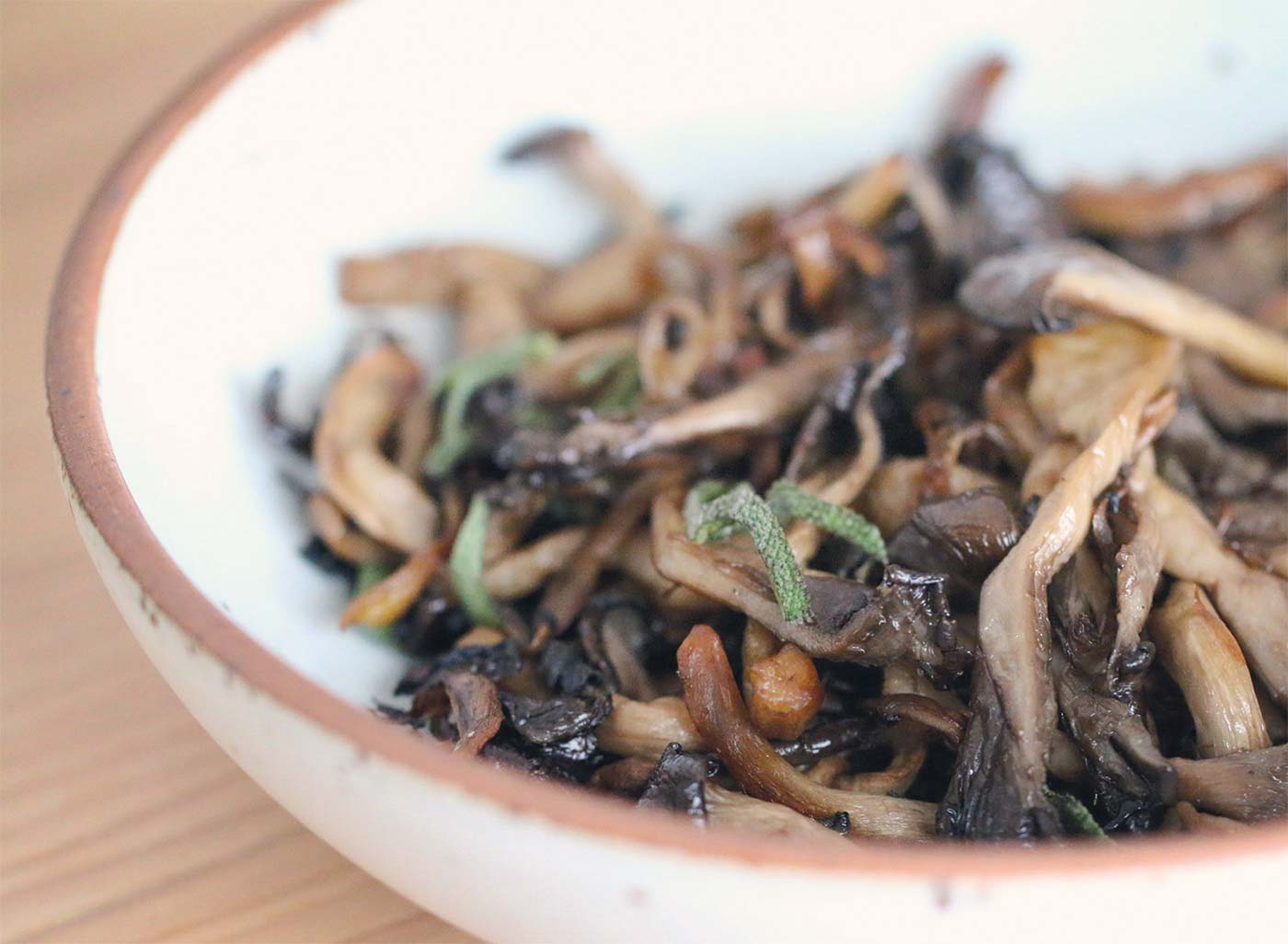
Roasted oyster mushrooms, just out of the oven
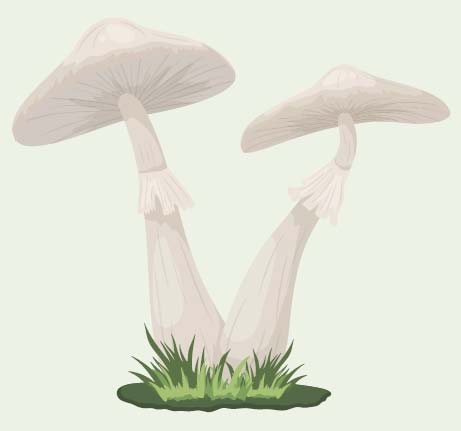
Death cap (Amanita phalloides) is highly poisonous.
SAFETY DISCLAIMER
There are deadly, poisonous wild plants and mushrooms in the region—never eat any wild food without 100-percent certainty and expert confirmation. Any foraging you undertake is at your own risk—when in doubt, throw it out.



